| iCitipati
| ||||||||||||||||||
|---|---|---|---|---|---|---|---|---|---|---|---|---|---|---|---|---|---|---|
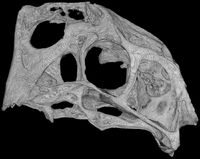 Upper portion of a Citipati osmolskae skull.
| ||||||||||||||||||
|
Extinct (fossil)
| ||||||||||||||||||
| Scientific classification | ||||||||||||||||||
| ||||||||||||||||||
|
Citipati (Sanskrit for 'funeral pyre lord') is a genus of oviraptorid theropod dinosaur from the Late Cretaceous Period of what is now Mongolia (specifically, the Djadokhta Formation of Ukhaa Tolgod, in the Gobi Desert). It is one of the best-known oviraptorids, thanks to a number of well-preserved skeletons, including several specimens found in brooding positions atop nests of eggs. These nesting specimens have helped to solidify the link between non-avian dinosaurs and birds.
Description
The largest Citipati were emu-sized animals and, at about 3 meters (9 ft) long, were one of the largest oviraptorids, ousted only by Gigantoraptor. Like other oviraptorids, Citipati had an unusually long neck and shortened tail, compared to most other theropods. Its skull was unusually short and highly pneumatized (riddled with openings in the bone structure), ending in a stout, toothless beak. Perhaps the most distinctive feature of Citipati was its tall crest, superficially similar to that of a modern cassowary. The crest was relatively low in the type species, C. osmolskae, and taller, with a pointed tip, in a referred specimen which has not yet been assigned a specific name (provisionally labelled C. sp.).
Citipati or Oviraptor?
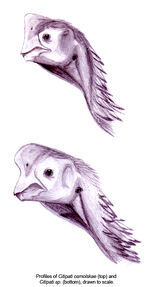
Citipati osmolskae and Citipati sp. comparison.
Since the type skull of Oviraptor is so poorly preserved and crushed, another oviraptorid specimen (IGN or GIN 100/42) had become the quintessential depiction of that dinosaur, even appearing in scientific papers with the label Oviraptor philoceratops [1]. However, this distinctive-looking, tall-crested species has more features of the skull in common with Citipati than it does with Oviraptor and it may represent a second species of Citipati or possibly an entirely new genus, pending further study [2]. Additionally, the nesting oviraptorid specimens had gained widespread attention before they were actually referred to Citipati. While usually labelled simply "oviraptorids", they have on occasion been confused with Oviraptor istelf. The fact that the first Oviraptor specimen was found on a nest as well confused the matter further. As it stands, most popular illustrations of Oviraptor actually depict Citipati and the present material available for Oviraptor itself is too fragmentary to be reliably reconstructed.
Name
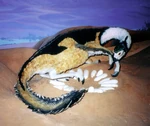
Model of Citipati osmolskae.
The name Citipati is formed from the Sanskrit words citi, meaning 'funeral pyre' and pati meaning 'lord'. In Tibetan Buddhist folklore, the citipati were two monks who were beheaded by a thief, while deep in a meditative trance [1]. The citipati are often depicted as a pair of dancing skeletons surrounded by flame, hence the application of the name to the beatifully preserved oviraptorid skeletons. The type species of Citipati, C. osmolskae, was named by Clark et al., in honor of Halska Osmólska, a noted paleontologist whose work has dealt extensively with oviraptorids and other Mongolian theropods [2].
Paleobiology
Nesting, eggs, and embryos
At least four Citipati specimens have been found in brooding positions, the most famous of which, a large specimen nicknamed "Big Mamma", was first announced (but not named) in 1995 [3], described in 1999 [4], and referred to the genus Citipati in 2001 [2]. All of the nesting specimens are situated on top of egg clutches, with their limbs spread symmetrically on each side of the nest, front limbs covering the nest perimeter. This brooding posture is found today only in birds and supports a behavioral link between birds and theropod dinosaurs [4]. The nesting position of Citipati also supports the hypothesis that it and other oviraptorids had feathered forelimbs. With the 'arms' spread along the periphery of the nest, a majority of eggs would not be covered by the animal's body unless an extensive coat of feathers was present [5].
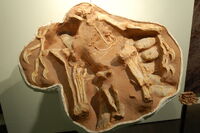
A nesting Citipati osmolskae specimen.
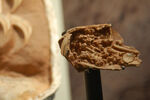
A Citipati osmolskae egg with preserved embryo.
Although fossilized dinosaur eggs are rare, Citipati eggs and oviraptorid eggs in general, are relatively well known. Along with the four known nesting specimens, dozens of isolated oviraptorid nests have been uncovered in the Gobi Desert. Citipati eggs are shaped like elongated ovals (elongatoolithid) and resemble the eggs of ratites in texture and shell structure. In the nest, Citipati eggs are typically arranged in concentric circles of up to three layers, and a complete clutch may have consisted of as many of 22 eggs [6]. The eggs of Citipati are the largest known definitive oviraptorid eggs, at 18 cm. In contrast, eggs associated with Oviraptor are only up to 14 cm long [4].
Ironically, it was the association with eggs that gave oviraptorids their name (which means 'egg thieves'). The first oviraptorid eggs (of the genus Oviraptor) were found in close proximity to the remains of the ceratopsian dinosaur Protoceratops and it was assumed that the oviraptorids were preying upon the eggs of the ceratopsians [7]. It was not until 1993, when a Citipati embryo was discovered inside one of the supposed Protoceratops eggs, that the error was corrected [8]. Norell et al., who recognized the embryo as oviraptorid, assigned it to the genus Citipati in 2001, based on the vertical orientation of the premaxilla (a bone structure at the tip of the jaw), a feature found only in Citipati. The egg containing the embryo was smaller than most known Citipati eggs at only 12 cm, though it was partially eroded and broken into three pieces, making an accurate estimate of its original size difficult [4]. The embryo-bearing egg was otherwise identical to other oviraptorid eggs in shell structure and was found in an isolated nest, again arranged in a circular pattern. Two indeterminate theropod skulls were associated with the nest [8].
References
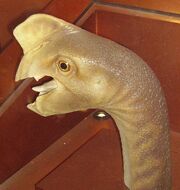
Bust of Citipati sp. at the Natural History Museum, London.
- ↑ Barsbold, R., Maryanska, T., and Osmolska, H. (1990). "Oviraptorosauria," in Weishampel, D.B., Dodson, P., and Osmolska, H. (eds.). The Dinosauria. Berkeley: University of California Press, pp. 249-258.
- ↑ 2.0 2.1 2.2 Clark, J.M., Norell, M.A., & Barsbold, R. (2001). "Two new oviraptorids (Theropoda:Oviraptorosauria), upper Cretaceous Djadokhta Formation, Ukhaa Tolgod, Mongolia." Journal of Vertebrate Paleontology 21(2):209-213., June 2001.
- ↑ Norell, M.A., Clark, J.M., Chiappe, L.M., and Dashzeveg, D. (1995). "A nesting dinosaur." Nature 378:774-776.
- ↑ 4.0 4.1 4.2 4.3 Clark, J.M., Norell, M.A., & Chiappe, L.M. (1999). "An oviraptorid skeleton from the Late Cretaceous of Ukhaa Tolgod, Mongolia, preserved in an avianlike brooding position over an oviraptorid nest." American Museum Novitates, 3265: 36 pp., 15 figs.; (American Museum of Natural History) New York. (5.4.1999).
- ↑ Paul, G.S. (2002). Dinosaurs of the Air: The Evolution and Loss of Flight in Dinosaurs and Birds. Baltimore: Johns Hopkins University Press.
- ↑ Varricchio, D.J. (2000). "Reproduction and Parenting," in Paul, G.S. (ed.). The Scientific American Book of Dinosaurs. New York: St. Martin's Press, pp. 279-293.
- ↑ Osborn, H.F. (1924). "Three new Theropoda, Protoceratops zone, central Mongolia." American Museum Novitates, 144: 12 pp., 8 figs.; (American Museum of Natural History) New York. (11.7.1924).
- ↑ 8.0 8.1 Norell, M. A., J. M. Clark, D. Dashzeveg, T. Barsbold, L. M. Chiappe, A. R. Davidson, M. C. McKenna, and M. J. Novacek (1994). "A theropod dinosaur embryo, and the affinities of the Flaming Cliffs Dinosaur eggs." Science 266: 779–782.
External links

|
This page uses content from Wikipedia. The original article was at Citipati. The list of authors can be seen in the page history. As with Paleontology Wiki, the text of Wikipedia is available under the GNU Free Documentation License. |